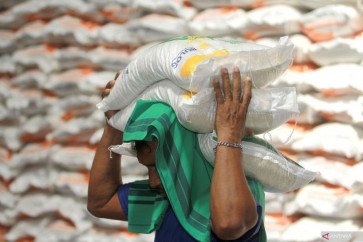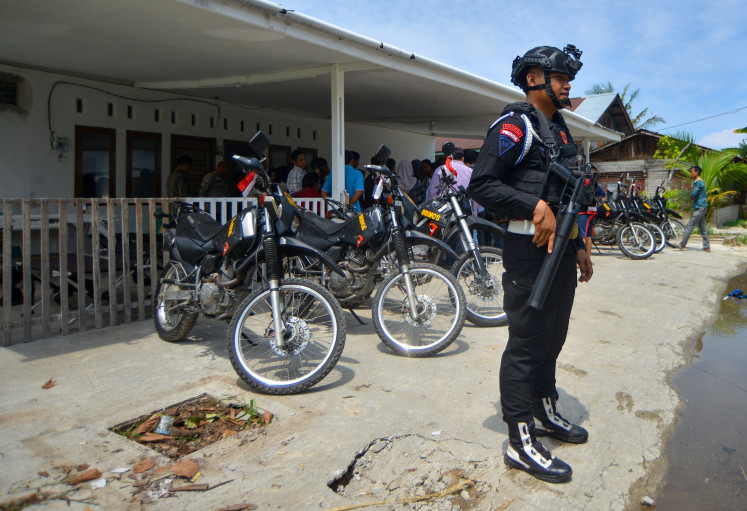Popular Reads
Top Results
Can't find what you're looking for?
View all search resultsPopular Reads
Top Results
Can't find what you're looking for?
View all search resultsExhibition displays Balinese traditional paintings
The majority within the Indonesian art community refers to Balinese paintings made during and following the Pitamaha era, which began in 1936, as traditional paintings, while foreign art critics and observers, ranging from J
Change text size
Gift Premium Articles
to Anyone
The majority within the Indonesian art community refers to Balinese paintings made during and following the Pitamaha era, which began in 1936, as traditional paintings, while foreign art critics and observers, ranging from J. Kats to Jean Couteau, label them "modern" and "contemporary".
Art critic Agus Dermawan T., excusing himself for flatly refusing such existing categorizations, decided to identify them as traditional-contemporary, referring to the post-Pitamaha era in which a number of distinctive styles or schools of painting emerged on the island.
The schools' styles are largely, but not exclusively, named for the regions where their founding artists lived and developed their own aesthetical horizons. They include the Kamasan, Batuan, Ubud, Sanur, Singaraja, Tanah Lot and Keliki styles.
Kupu-kupu Arts Project Management is now exhibiting a number of paintings by Batuan and Keliki painters at the Centre for Strategic and International Studies' office. The exhibition, entitled "Pesta Puri: The Batuan Jocularity and Keliki Magic", runs from April 10 to 17.
The two styles, Agus said, are historically related. "The Keliki School is known as the Batuan School's child". This is in consideration of the fact that, previously, Keliki painters lived in Ubud, socialized with students of the Ubud School and were regarded as children of Ubud painting. Batuan nurtured them," he said.
"The exhibition is intended to show Batuan and Keliki contemporary-traditional paintings. It is an exhibition of works by the *father' and the*step-child'. By presenting works of the masters... it is showing the true features of the Batuan and Keliki painting worlds."
While incorporating characteristics common to Balinese paintings -- idyllic landscapes, exotic agricultural life and mystifying cultural festivities and symbols - the painters of the two schools have been drawn into different art directions.
Batuan is a village in Sukawati sub-district in the Gianyar regency. Initially, the Batuan painters adopted tantric stories, fables and mythology as themes for their works. They later came to adopt the themes of modern Bali marked by a tourism boom and some began to take relevant daily events and occurrences as themes for their paintings.
I Ketut Sadia, a celebrated Batuan painter, for instance, humorously used the crippling floods in Jakarta for one of his painting themes, named "Banjir Ria Jakarta". It is indeed rare to see tall buildings featured in a Balinese painting as such architectural fancies are traditionally prohibited by Balinese culture.
Despite such thematic changes, the techniques involved, Agus explained, remain traditional, incorporating phases that begin with ngorten (penciled original sketches) to be followed by nyawi (inking to make the sketches more definite), ngucak (working on the effect of distance and chiaroscuro), menyunin (working on the impression of volume), nyawi (developing ornaments and details in colors) and ngewarna (coloring).
"Batuan paintings generally have eerily gripping atmospheres. In the beginning, painters mostly worked with the black-and-white technique known locally as sigar mangsi. Dark green and brown tones are sometimes added to give a monochromatic quality to the paintings," Agus said.
The Keliki School was pioneered by I Ketut Sana, an agricultural worker who learned to paint by "stealing" painting techniques he observed while living in Ubud.
"With all his potency, Sana went on painting and teaching his art to fellow Keliki villagers. Amazingly, by 1980, Keliki had already turned the village toward mini painting. Mini painting is now a major school pursued by tens of potential painters," Agus said.
He considers the meticulousness of Keliki paintings -- with their tradition of small-sized paintings on which, for instance, a grain of rice is volumetrically depicted as small as one-fourth of a millimeter -- as the most miraculous quality of Balinese painting.
"They are Keliki painters who, through their magical works, have succeeded in winning the attention of art lovers throughout the world. As they are, these works are not -- completely different from the sort of works we commonly see at ordinary art shops in Bali," he said.










